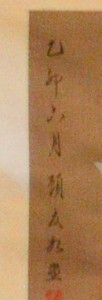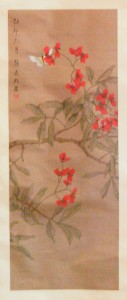A few months back, Amelie wore this set when we went out for shabu-shabu and I commented on how much I loved it and how I’d been wanting one of these matched sets for a while, but never found one that would fit me. Because Amelie is a total sweetheart and a very generous person, she offered the set to me as a late birthday/Christmas present. I couldn’t say no!
I love wool kimono for their versatility, ease of wear, and comfort. They’re wool so they can be nice and warm, but they’re unlined and relatively breezy so they’re comfortable in warmer months too. They’re also typically woven with bold geometric motifs, so they’re seasonless. They’re a great casual addition to any kimono wardrobe.
This one also appeals to my inner ex-goth (if you’re curious to see how I dressed when going out when I was younger, click here or here) due to the black and red colour scheme. What can I say, I’m easily amused.
Not only is it adorable, it’s also more than big enough for me, which really shocked me considering how tiny Amelie is XD. I can’t wait to wear it!







































 Bebe Taian
Bebe Taian CHOKO Blog
CHOKO Blog Gion Kobu
Gion Kobu